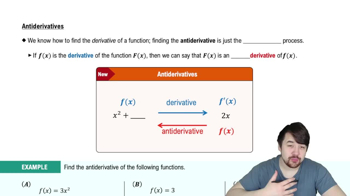Give the antiderivatives of xᵖ . For what values of p does your answer apply?
Table of contents
- 0. Functions7h 54m
- Introduction to Functions16m
- Piecewise Functions10m
- Properties of Functions9m
- Common Functions1h 8m
- Transformations5m
- Combining Functions27m
- Exponent rules32m
- Exponential Functions28m
- Logarithmic Functions24m
- Properties of Logarithms36m
- Exponential & Logarithmic Equations35m
- Introduction to Trigonometric Functions38m
- Graphs of Trigonometric Functions44m
- Trigonometric Identities47m
- Inverse Trigonometric Functions48m
- 1. Limits and Continuity2h 2m
- 2. Intro to Derivatives1h 33m
- 3. Techniques of Differentiation3h 18m
- 4. Applications of Derivatives2h 38m
- 5. Graphical Applications of Derivatives6h 2m
- 6. Derivatives of Inverse, Exponential, & Logarithmic Functions2h 37m
- 7. Antiderivatives & Indefinite Integrals1h 26m
- 8. Definite Integrals4h 44m
- 9. Graphical Applications of Integrals2h 27m
- 10. Physics Applications of Integrals 3h 16m
- 11. Integrals of Inverse, Exponential, & Logarithmic Functions2h 34m
- 12. Techniques of Integration7h 41m
- 13. Intro to Differential Equations2h 55m
- 14. Sequences & Series5h 36m
- 15. Power Series2h 19m
- 16. Parametric Equations & Polar Coordinates7h 58m
7. Antiderivatives & Indefinite Integrals
Antiderivatives
Problem 4.9.17
Textbook Question
Finding antiderivatives. Find all the antiderivatives of the following functions. Check your work by taking derivatives.
ƒ(y) = - 2/y³
 Verified step by step guidance
Verified step by step guidance1
Step 1: Recall the general rule for finding antiderivatives. The antiderivative of a function is the reverse process of differentiation. For power functions, the antiderivative of yⁿ is (y^(n+1))/(n+1), provided n ≠ -1.
Step 2: Rewrite the given function ƒ(y) = -2/y³ using exponents. Since 1/y³ is equivalent to y⁻³, the function becomes ƒ(y) = -2y⁻³.
Step 3: Apply the antiderivative rule to -2y⁻³. Increase the exponent by 1 (from -3 to -2) and divide by the new exponent (-2). This gives the antiderivative as (-2 * y⁻²)/(-2).
Step 4: Simplify the expression obtained in Step 3. The -2 in the numerator and denominator cancel out, leaving y⁻² or 1/y². Add the constant of integration, C, to account for all antiderivatives. The result is F(y) = 1/y² + C.
Step 5: Verify your work by differentiating F(y). Differentiate F(y) = 1/y² + C using the power rule and confirm that the derivative is ƒ(y) = -2/y³, which matches the original function.
 Verified video answer for a similar problem:
Verified video answer for a similar problem:This video solution was recommended by our tutors as helpful for the problem above
Video duration:
4mPlay a video:
Was this helpful?
Key Concepts
Here are the essential concepts you must grasp in order to answer the question correctly.
Antiderivative
An antiderivative of a function is another function whose derivative is the original function. In calculus, finding antiderivatives is essential for solving problems related to integration. The process involves determining a function F(y) such that F'(y) = f(y). Antiderivatives are not unique; they can differ by a constant, represented as F(y) + C, where C is any constant.
Recommended video:

Antiderivatives
Power Rule for Integration
The Power Rule for Integration is a fundamental technique used to find antiderivatives of polynomial functions. It states that the integral of y^n, where n is not equal to -1, is (y^(n+1))/(n+1) + C. This rule simplifies the process of finding antiderivatives by allowing us to easily handle terms with exponents, making it particularly useful for functions like f(y) = -2/y³.
Recommended video:

Power Rule for Indefinite Integrals
Verification by Differentiation
Verification by differentiation involves checking the correctness of an antiderivative by taking its derivative. If the derivative of the antiderivative matches the original function, the solution is confirmed. This step is crucial in calculus to ensure that the integration process was performed correctly and helps reinforce the relationship between differentiation and integration.
Recommended video:

Finding Differentials
Related Videos
Related Practice
Textbook Question
20
views


